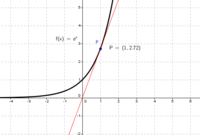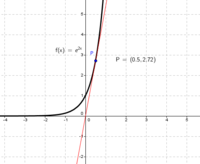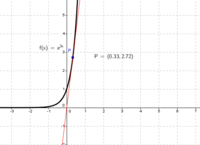Hi, I am exploring ways to think about this problem and would welcome any graphical insights. I can prove that this happens algebraically but i am trying to see whether there is some kind of visual explanation? My sense is there ought to be something along the lines of transformations and stretches but can't piece it together so any thoughts would be much appreciated!
Take y= e^x and consider a point on the curve so that the tangent at that point passes through the origin:

The x coordinate of Point P is 1
Moving further and now consider y= e^(2x). Where would you expect the point P to be?

It turns out that the x coordinate of point P is now 1/2
And for y= e^(3x) and x coordinate of point P is 1/3
etc..

etc... Is there a geometric explanation?
Take y= e^x and consider a point on the curve so that the tangent at that point passes through the origin:

The x coordinate of Point P is 1
Moving further and now consider y= e^(2x). Where would you expect the point P to be?

It turns out that the x coordinate of point P is now 1/2
And for y= e^(3x) and x coordinate of point P is 1/3
etc..

etc... Is there a geometric explanation?
